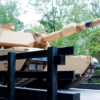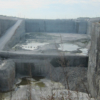Overview
On Water Street in Brooklyn, NY (USA), in the Fulton Ferry Historic District, reside several buildings with significant historical importance to the City of New York. These include the Empire Stores and roofless Tobacco Warehouse buildings.
These buildings date from 1869 and uniquely represent a part of the city that for the most part has long since disappeared. Both facilities are State-owned and abut Fulton-Empire Ferry Park. They were purchased in 1978, along with several other buildings, from Con Edison. These buildings were part of the original port facilities of the City of New York. Empire Stores formerly was used as a warehouse for coffee arriving by ship, Tobacco Warehouse was used to warehouse tobacco shipments shipped from the United States.
Empire Stores is distinctive with its massive red-brick walls and round-arch openings and iron shutters, characteristic of port warehouses of the period. Empire Stores is in a significant state of deterioration, numerous proposals have been offered to rehabilitate the buildings but to date none have been accepted.
A view of the front brick façade of Empire Stores is shown at right.
What We Did
The water main beneath Water Street required rehabilitation. Both Empire Stores and Tobacco Warehouse front Water Street, the excavation and installation of the proposed 36” water main would potentially have caused structural instability.
A Leica TM30 robotic survey station was deployed to provide automated data collection from numerous prisms located along the front of the historic buildings. The prisms provide for very accurate targeting and displacement monitoring in 3 dimensions. The TM30 was installed on the roof of a nearby building, this required use of a network of 7 reference prisms located outside the excavation area to automatically correct for robot movement.
A Campbell Scientific CR1000 was deployed to automate the TM30. A Raven cellular IP modem was connected to the CR1000 to provide remote access to the CR1000. Our MultiLogger software was used to collect data every 15 minutes, then our database software reduced the angles and distance measurements to displacements in millimeters in 3 directions. Automated notifications were sent to the owner and construction personnel in the event of thresholds being exceeded. Our software also provided weekly reporting to summarize the monitoring data.
We were contracted to provide on-site services related to the robot deployment including use of our MultiLogger Total Station functionality to automate the TM30, build the project database including reference and displacement calculations, configure all alarm and weekly reporting, host the database and provide ongoing support to the surveyor, constructor and owner. Access to the monitoring data and reporting was provided using web login with our MLWeb software which is included with our MultiLogger Suite software package.
A view of the MLWeb interface is shown to the right.


